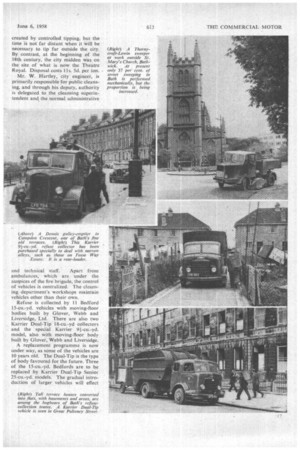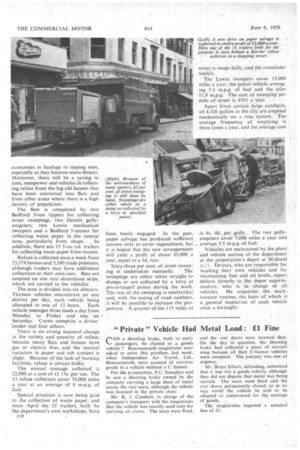Public Cleansing Under Difficulties
Page 60

Page 61

Page 62

If you've noticed an error in this article please click here to report it so we can fix it.
By A. E. Sherlock-lViesher
DESPITE its .architectural and .historic .splendour, Bath is no sinecure for the public cleansing officer. Its topography presents a variety of difficulties in refuse collection and street sweeping similar to thosefound in the neighbouring city of Bristol, which . I described on June 14 •last.-yeari, although in some respects they are probably more. acute. Bath is approximately circular in plan, extending .four milesfroth east to west and 3+ miles from northto south, with' an area of 6,277acres and a population Of: 79,275. It. is bisected by,tlie River Avon, Which creates the familiar bridge problem; With attendant traffic congestion. . From each side.of the river the city rises steeply by as much as 645. ft. (minimum and : m.atimum. -heights ... above sea level are 55 ft. and 700.ft., respectively) in spur formation. The main city area is principally residential, with a small amount of industry and Government offices. Open spaces are fairly widespread: . The ' central and older' residential parts have narrow streets, in. •sorne cases. extremely steep; With houses built in terraces.. A curious phenomenon is the 6:instruction of . some of the streets on stone arches, which form cellars for householders. These streets are 22 ft above the original Roman 'level and are raised to avoid _flooding by the Avon. .. .
Many terrace houses have to be approached by refuse. collectors through awkward . back lanes, for which a Karrier 91-cu.yd. vehicle has had specially to be purchased. Bins are frequently stored in basements and in areas, and many of the old houses have been converted into flats, so that the number of bins has been multiplied: Long and awkward carries are the rule. Nevertheless, there is little difficulty in keeping labour, because competition from industry is not keen.
Another source of delay in refuse collection is the heavy traffic in the central area, and the holiday traffic on -the main roads to London and the West. At the time of my visit there seemed not to be a square foot of available road space in the centre of the
city that was, not occupied by a parked car.
Conditions are, however, easier on the housing estates on the northern, western and southern fringes.
Parked cars are one of the main bugbears of the street sweepers, and to avoid them work in the central area
begins at 5.30 a.m. Trees present further obstruction, and in some streets The camber is so great that mechanical methods of sweeping are impossible. In these cases, work is being done to reduce the camber, but progress is necessarily slow.
Apart from leaves from trees, the quick run-off rain from the hills can soon block gullies and a close watch must be kept on • them in wet weather.
One of the few benefits accruing to the cleansing department is the location of their depot practically centrally in the city, so that there is little waste mileage on refuse collection, street sweeping and gully ernpping. Almost the only dead mileage is in running to the disposal tip-ori the western boundary.
Playing fields have been created by controlled tipping, but the time is not far distant when it will be necessary to tip far outside the city. By contrast, at the beginning of the 18th century, the city midden was on the site of what is now the Theatre Royal. Disposal costs lls. 5d. per ton.
Mr. W. Hartley, city engineer, is primarily responsible for public cleansing, and through his deputy, authority is delegated to the cleansing superintendent and the normal administrative and technical staff. Apart from ambulances, which are under the auspices of the fire brigade, the control of vehicles is centralized. The cleansing department's workshops maintain vehicles other than their own.
Refuse is collected by 11 Bedford 15-cu.-yd. vehicles with moving-floor bodies built by Glover, Webb and Liversidge, Ltd. There are also two Karrier Dual-Tip 18-cu.-yd collectors and the special Karrier model, also with moving-floor body built by Glover, Webb and Liversidge.
A replacement programme is now under way, as some of the vehicles are 10 years old. The Dual-Tip is the type of body favoured for the future. Three of the 15-cu.-yd. Bedfords are to be replaced by Karrier Dual-Tip Senior 25-cu.-yd. models. The gradual introduction of larger vehicles will effect economies in haulage to .tipping sues, especially as they become more distant. Moreover, there will be a saving in Lime, manpower and vehicles in collecting refuse from the big old houses that have been converted into flats and from other areas where there is a high density of population.
The fleet is completed by two Bedford 5-ton tippers for collecting Street sweepings, two Dennis gullyemptierS, two Lewin mechanical sweepers and a Bedford 5-tanner for collecting waste paper in the central
area, particularly from shops. In addition, there are 15 5-cu.-yd. trailers for collecting waste paper from houses.
Refuse is collected once a week from 23,174 houses and 3,100 trade premises, although traders may have additional collections at their own cost. Bins are emptied on site into aluminium skips, which are carried to the vehicles.
The area is divided into six districts. Thirteen vehicles concentrate on one district per day, each vehicle being allocated to one of 13 beats. Each vehicle manages three loads a day from Monday to Friday and one on • Saturday. Crews comprise a driverloader and four others.
There is rio strong seasonal change in the variety and quantity of refuse, because many flats and houses have gas or electric fires and the normal variation in paper and ash content is slight. Because of the lack of burning facilities, refuse is always bulky.
The annual tonnage collected is 22,000 at a cost of it 15s. per ton. The 13 refuse collectors cover 74,000 miles a year at an average of 6 m.p.g. of fuel.
Special attention is now being paid to the collection of waste paper, and since April the 15 trailers, built by the department's own workshops, have
been busily engaged. In the past, paper salvage has produced sufficient income only to cover expenditure, but it is hoped that the new arrangements will yield a profit of about £5,000 a year, equal to a Id. rate.
Sixty-three per cent. of street sweep ing is undertaken manually. The sweepings are either taken straight to dumps or are collected by a lorry at pre-arranged points during the work. The rest of the sweeping is mechanical and, with the -easing of road cambers, it will be possible to increase the proportion. A quarter of the.115 miles of street is swept daily, and the remainder 'weekly. .
The. Lewin Sweepers cover 11,000 miles a year,-. the petrol vehicle aVeraging 5.3 m.p.g. of fuel and the oiler 11.9 m.p.g. The cost of Sweeping per mile of street is £193 a year.
Apart from certain large catchpits, all 4,326 gullies in the city are emptied mechanically on a rota system. The average frequency of emptying is three times a year, and the average cost is 4s. 4d. per gully. The two gullyemptiers cover 7,000 miles a year and average 5.5 m.p.g. of fuel.
Vehicles are maintained by the plant and vehicle section of the department at the corporation's depot at Midland 1. Drivers, who are responsible for washing their own, vehicles and for maintaining fuel and oil levels, report defects directly to the depot superintendent, who is in charge of all vehicles. He organizes the maintenance routine, the basis of which is a, general inspection of each vehicle once a fortnight.








































































































































